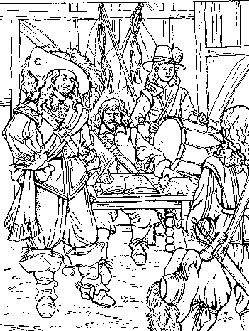 At the time of the Civil War, there was no regular army and there had been no major wars in England for over a hundred years. There had been wars in Europe and British mercenaries (paid by foreign countries to fight for them) had fought for Holland, Spain, France and Sweden, so that there were some professional soldiers trained in the arts of war. There were also the ‘trained bands’ which were units raised by each county for its own defence. These troops, who drilled for a few days each year, were not expected to serve outside their counties; they did not wear uniforms but there were at least weapons for them which they were taught to use in case of war.
At the time of the Civil War, there was no regular army and there had been no major wars in England for over a hundred years. There had been wars in Europe and British mercenaries (paid by foreign countries to fight for them) had fought for Holland, Spain, France and Sweden, so that there were some professional soldiers trained in the arts of war. There were also the ‘trained bands’ which were units raised by each county for its own defence. These troops, who drilled for a few days each year, were not expected to serve outside their counties; they did not wear uniforms but there were at least weapons for them which they were taught to use in case of war.
When King Charles raised his standard at Nottingham the only troops he had were some horse guards called the ‘gentlemen pensioners’ and his Yeomen of the Guard. He raised the great army which fought at Edgehill by issuing orders called ‘commissions of array’ which was an ancient right the King had to require his supporters to recruit men to fight for him.
The King now gave these commissions to rich and powerful men in every county and they in turn commissioned some of their followers (often their own sons) as colonels to raise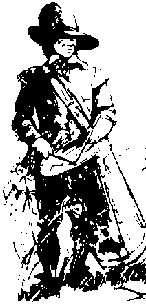 volunteers ‘by beat of drum’. This meant going round the towns and villages with a drummer calling on men to join the King’s army. (We still speak of ‘drumming up’ support for something.) The pay offered by the recruiting officers was 30p a week for musketeers, 68p for dragoons and 75p for horsemen. Men from the trained bands were the first to volunteer and then a flood of men came forward to the King’s support.
volunteers ‘by beat of drum’. This meant going round the towns and villages with a drummer calling on men to join the King’s army. (We still speak of ‘drumming up’ support for something.) The pay offered by the recruiting officers was 30p a week for musketeers, 68p for dragoons and 75p for horsemen. Men from the trained bands were the first to volunteer and then a flood of men came forward to the King’s support.
Parliament raised its army in a similar way. The main difference was that whereas the King had no money and relied upon his supporters to pay for the army they raised, Parliament could vote the money they needed and raise it by taxes. They could pay for the recruiting of their men but the pay they offered their recruits was exactly the same as that offered to recruits for the King.
Charles had raised his standard at Nottingham on August 22 1642 and the Battle of Edgehill was fought only two months later, on October 23. In that short time, both sides had raised armies of 10,000 men. It is not really surprising that the battle ended as it did. For nearly all the troops of both sides, it was their very first experience of war.
At the Battle of Edgehill serious fighting did not really begin until the foot soldiers met and fought at ‘push of pike’. This was considered to be’ the proper way to fight a battle and for a long time field guns were considered very ‘unsporting’ because the gunners never saw the men they killed, face to face. Pikes were sixteen feet long and made of ash with a steel head attached to the wooden shaft by metal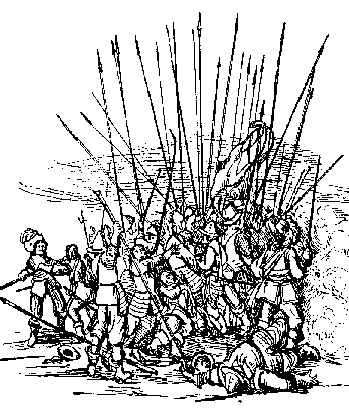 straps.
straps.
There were four types of pike:

From left to right: the type carried by the ordinary pikemen; the ‘halberd’, carried by the sergeants; the ‘partisan’, used by officers; the ‘spontoon’, which was also carried by officers and was sometimes called a ‘half-pike’.
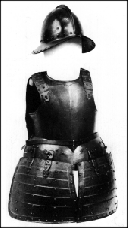 Although hand-to-hand combat was still a feature of seventeenth-century warfare, the ‘missile’ element of infantry fighting was increasing steadily, the longbow having been replaced by increasingly efficient firearms, for, as Daniel Lupton wrote, ‘pikemen could only receive the messengers of death but Musquetiers can send them’ . But as musketeers could not adequately defend themselves against a cavalry charge, men armed with pikes remained a necessity for action in the open field, the proportion of musketeers to pikemen was increasing steadily, until some regiments were fielded without any pikemen, though these were very much the exception.
Although hand-to-hand combat was still a feature of seventeenth-century warfare, the ‘missile’ element of infantry fighting was increasing steadily, the longbow having been replaced by increasingly efficient firearms, for, as Daniel Lupton wrote, ‘pikemen could only receive the messengers of death but Musquetiers can send them’ . But as musketeers could not adequately defend themselves against a cavalry charge, men armed with pikes remained a necessity for action in the open field, the proportion of musketeers to pikemen was increasing steadily, until some regiments were fielded without any pikemen, though these were very much the exception.
The pikeman was equipped with a considerable weight of armour to protect himself, including breast and backplates, tassets (thigh guards breastplate) and a gorget (an iron collar), though the two latter items declined in use during the Civil Wars as being too cumbersome for their worth.
 Pistols and muskets at this time were loaded through the open end of the barrel. Loose gunpowder was poured in, then the ‘shot’ and iron ball, then a wad of rag or paper was rammed down on top with a ramrod and the musket was ready to be fired.
Pistols and muskets at this time were loaded through the open end of the barrel. Loose gunpowder was poured in, then the ‘shot’ and iron ball, then a wad of rag or paper was rammed down on top with a ramrod and the musket was ready to be fired.
This meant that the gunpowder imprisoned inside the barrel had somehow to be set on fire so that it would explode and shoot the ball out of the barrel. This was done by leaving a tiny hole at the closed end of the barrel above the gunpowder called the ‘touch hole’ through which a hot flame could be sent to explode the gunpowder.
The flame was made by pouring some more gunpowder into a ‘pan’ on top of the touch hole and then setting it off. The musketeers did this by means of a length of rope soaked in saltpetre to make it smoulder. This was called the ‘match’ and it was lit at both ends. One lighted end was then fixed to the ‘cock’ which snapped the match down into the powder in the pan when the trigger was pulled. This, of course, fired the gun. This kind of musket was called a ‘matchlock’. It was very clumsy to load and a musketeer was lucky if he could fire three rounds in a minute. A well-aimed shot might hit a man sixty yards away.
top of the touch hole and then setting it off. The musketeers did this by means of a length of rope soaked in saltpetre to make it smoulder. This was called the ‘match’ and it was lit at both ends. One lighted end was then fixed to the ‘cock’ which snapped the match down into the powder in the pan when the trigger was pulled. This, of course, fired the gun. This kind of musket was called a ‘matchlock’. It was very clumsy to load and a musketeer was lucky if he could fire three rounds in a minute. A well-aimed shot might hit a man sixty yards away.
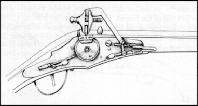 On horseback, of course, it was difficult enough to load musket or pistol with powder and shot without having to fix lighted match in place, so the cavalry carried ‘wheel-lock’ or ‘flintlock’ pistols or muskets. The wheel lock was wound up with a key against a powerful spring and when it was released by the trigger, a serrated ring around the wheel turned against a piece of flint sending a stream of sparks into the pan.
On horseback, of course, it was difficult enough to load musket or pistol with powder and shot without having to fix lighted match in place, so the cavalry carried ‘wheel-lock’ or ‘flintlock’ pistols or muskets. The wheel lock was wound up with a key against a powerful spring and when it was released by the trigger, a serrated ring around the wheel turned against a piece of flint sending a stream of sparks into the pan.
The flintlock simply had a piece of flint clamped into the cock which, when released by the trigger, snapped down on to a steel plate causing a spark to flash into the pan full of powder. Sometimes it misfired and the powder in the pan burned but did not set off the main charge in the barrel. It is from this that we get the expression ‘only a flash in the pan’ for something that doesn’t happen very often or not quite come off.
trigger, snapped down on to a steel plate causing a spark to flash into the pan full of powder. Sometimes it misfired and the powder in the pan burned but did not set off the main charge in the barrel. It is from this that we get the expression ‘only a flash in the pan’ for something that doesn’t happen very often or not quite come off.
 The guns used during the Civil War were of all different shapes and sizes. They varied from a ‘cannon royal’ which fired a sixty-three pound shot, to a ‘robinet’ which fired a shot weighing only three quarters of a pound.
The guns used during the Civil War were of all different shapes and sizes. They varied from a ‘cannon royal’ which fired a sixty-three pound shot, to a ‘robinet’ which fired a shot weighing only three quarters of a pound.
At Edgehill, King Charles had a total of twenty guns of which two were tiny robinets, twelve were falcons and falconetts which fired 2½ and 1½ lb shots; four were culverins and demi-culverins firing fifteen pound and nine pound shots; and the only two big guns were two demi-cannons which fired shots weighing twenty-seven pounds. They were loaded in exactly the same way as a musket with a touch hole leading to the main charge.
Each gun was served by a gunner and his mate with one or more labourers to help carry the shot and move the gun to new sites during the battle. They fired ’round shot’ or cannon balls but could also be loaded with canisters of musket balls, which were very deadly fired at short range against men in close formation.
The guns were’ usually sited in the intervals between formations of foot-soldiers. The heavier guns were sometimes placed behind the infantry to fire over their heads. The guns the two Princes saw firing at Edgehill were placed halfway up the hill but they were not of much use because, instead of bowling along the ground when they landed, their cannon balls fell almost vertically and buried themselves in the soft ground.


